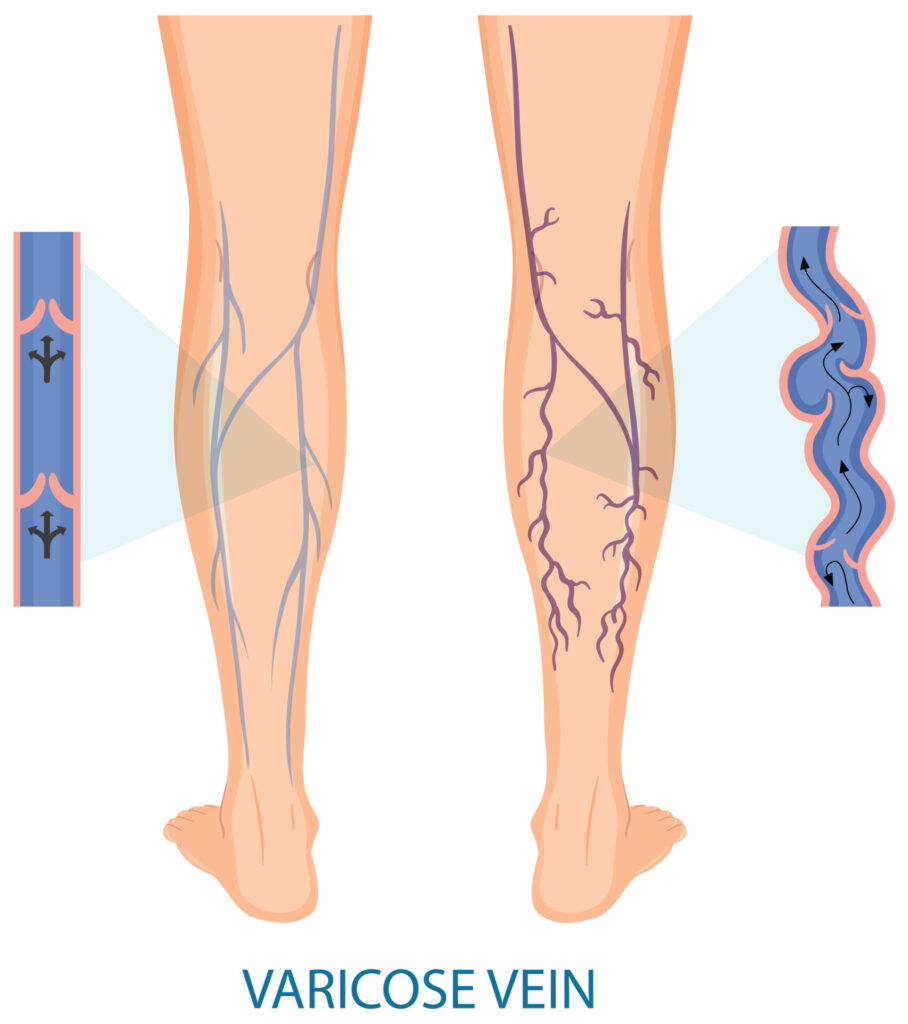Expert Laser Therapy for Spider and Varicose Veins Treatment

Spider and varicose veins are common venous disorders affecting millions of individuals worldwide. These conditions can cause discomfort and may also impact one’s self-esteem. Understanding the nature of spider and varicose veins, as well as the causes behind them, is essential in order to explore effective treatment options such as laser therapy and sclerotherapy.
Understanding Spider and Varicose Veins
What are Spider Veins?
Spider veins, also known as telangiectasias, are small, damaged veins that may appear on the surface of the legs or face. They often look like a spider web, with a central point and thin, jagged lines spreading outward. These veins may not cause physical symptoms, but they can be a cosmetic concern for many individuals.
What are Varicose Veins?
Varicose veins are larger, swollen, and twisted veins that typically develop in the legs. They can cause achy or heavy sensations in the legs and may also lead to more serious complications such as skin ulcers or blood clots. Varicose veins are often caused by weakened or damaged valves in the veins, allowing blood to flow backward and collect in the veins.
Causes of Vein Disorders
Vein disorders, including spider and varicose veins, can be attributed to various factors such as genetics, hormonal changes, obesity, and prolonged standing or sitting. These conditions can also be influenced by age and gender, with women being more predisposed to developing spider or varicose veins at a certain point in their lives. The pathophysiology of vein disorders involves impaired circulation and increased pressure within the affected veins, leading to their characteristic appearance and symptoms.
Laser Treatment Options
When it comes to addressing spider and varicose veins, laser therapy is a prominent treatment option. Laser therapy involves the use of concentrated beams of light energy to target and treat the affected veins. This treatment is considered minimally invasive and offers a range of potential benefits for individuals seeking to address their vein concerns.
Overview of Laser Therapy
Laser therapy for spider and varicose veins entails the utilization of laser light to heat and damage the problematic veins. This process prompts the body to absorb the damaged veins, redirecting the blood flow to healthier veins. There are different types of laser treatments available, each catering to specific vein conditions and patient needs.
Types of Laser Treatment
Endovenous laser treatment is a popular option for addressing larger varicose veins. This technique involves inserting a laser fiber into the affected vein, emitting heat that causes the vein to collapse and be reabsorbed by the body. On the other hand, surface laser treatment is effective for smaller spider veins, targeting them with precise bursts of laser energy, ultimately leading to their fading and disappearance.
Potential Benefits of Laser Therapy
Laser therapy for spider and varicose veins offers several advantages, including minimal discomfort, shorter recovery periods, and reduced risk of scarring. Additionally, this treatment may result in improved cosmetic appearance and enhanced self-confidence for individuals dealing with vein-related concerns. Consulting with a dermatologist or vein specialist can help determine the most suitable vein treatment plan, whether it involves laser therapy, sclerotherapy, or a combination of approaches.
Specialized Laser Treatments for Veins

When it comes to specialized laser treatments for veins, there are various options to address different vein disorders. Laser therapy has become a prominent choice for individuals seeking effective treatment for spider and varicose veins. Understanding the specific laser treatments available and their potential benefits is crucial for individuals looking to address their vein concerns.
Laser Therapy for Spider Veins
Laser therapy is often utilized as an effective treatment for spider veins. This minimally invasive procedure involves the use of concentrated laser energy to target and treat the affected veins. By emitting precise bursts of laser energy, spider veins can be effectively treated, leading to their fading and eventual disappearance. This approach offers minimal discomfort and shorter recovery periods for individuals undergoing the treatment, enhancing their overall satisfaction with the results.
Laser Treatment for Varicose Veins
For larger varicose veins, laser therapy can also be a suitable treatment option. Endovenous laser treatment, in particular, involves inserting a laser fiber into the affected vein, directing heat to collapse the vein and facilitate its absorption by the body. This method provides a targeted and efficient solution for addressing varicose veins, ultimately aiding in improving overall circulation and reducing discomfort associated with the condition.
Endovenous Laser Ablation (EVLA)
Endovenous laser ablation (EVLA) is a specialized laser treatment that is specifically designed to address larger varicose veins. It entails utilizing laser light to effectively destroy the problematic veins, allowing the body to reabsorb them over time. This procedure offers numerous benefits, including minimal scarring, improved cosmetic appearance, and reduced risk of complications compared to traditional vein surgery.
Sclerotherapy and Other Treatments
In addition to laser therapy, sclerotherapy is another commonly utilized treatment for vein disorders. Understanding the various treatment modalities, including alternative options and the potential benefits of combining different treatments, is essential for individuals seeking comprehensive care for their vein concerns.
Understanding Sclerotherapy
Sclerotherapy involves the injection of a specialized solution directly into the affected veins, causing them to collapse, close, and eventually be reabsorbed by the body. This minimally invasive procedure is particularly effective for treating small spider veins and can be combined with laser therapy for comprehensive treatment of both small and larger veins.
Alternative Treatments for Vein Disorders
Aside from laser and sclerotherapy treatments, alternative options for vein disorders include lifestyle modifications, such as the use of compression stockings and regular physical activity to improve circulation. These approaches can complement the effects of medical treatments, providing individuals with a holistic approach to managing their vein concerns.
Combining Laser Therapy with Other Treatments
Combining laser therapy with other treatment modalities, such as sclerotherapy or lifestyle modifications, can offer individuals a comprehensive approach to managing their vein disorders. By leveraging the benefits of different treatments, individuals can optimize their outcomes and experience long-term improvements in their vein health and overall well-being.
Spider and varicose veins affect millions of individuals worldwide, and understanding the nature of these conditions is essential for exploring effective treatment options. Laser therapy and sclerotherapy are common treatments for addressing vein concerns. When considering laser therapy, there are several factors to take into account that can influence the choice of treatment. It’s important to consult with a dermatologist or vein specialist to discuss personalized treatment plans tailored to individual needs and conditions.
Choosing the Right Treatment
When choosing laser therapy for spider and varicose veins, there are several factors to consider. It’s essential to evaluate the size and location of the affected veins, as different laser treatments cater to specific vein conditions. Additionally, the expertise of the healthcare provider and the overall suitability of laser therapy for an individual’s condition should be taken into consideration.
Factors to Consider When Choosing Laser Therapy
Factors such as the size and severity of the affected veins, the individual’s overall health, and any previous treatments should be carefully evaluated when considering laser therapy. The specific type of laser treatment, whether for spider veins or larger varicose veins, must be chosen based on the unique characteristics of the vein disorder.
Consulting with a Dermatologist
Consulting with a dermatologist or vein specialist is crucial for determining the most suitable treatment plan. These healthcare professionals can assess the severity of the vein condition, discuss the potential benefits and risks of laser therapy, and provide personalized recommendations based on the individual’s specific needs.
Personalized Treatment Plans
Personalized treatment plans take into account the unique characteristics of an individual’s vein disorder, ensuring that the chosen laser therapy is tailored to address the specific concerns and goals of the patient. By considering all relevant factors and consulting with a healthcare professional, individuals can make informed decisions regarding their vein treatment.
Benefits and Risks of Laser Therapy
Laser therapy offers various advantages for individuals seeking to address spider and varicose veins. However, it’s important to understand the potential risks and long-term outcomes associated with this treatment approach.
Advantages of Laser Treatment
Laser therapy presents several benefits, including minimal discomfort during the treatment, shorter recovery periods, and the potential for improved cosmetic appearance of the treated area. Additionally, it can result in enhanced self-confidence for individuals dealing with vein-related concerns.
Potential Risks and Side Effects
While laser therapy is generally considered safe, potential risks and side effects may include temporary redness, swelling, or bruising in the treated area. It’s important to discuss these potential effects with a healthcare provider before undergoing laser therapy to ensure an informed decision.
Long-Term Outcomes and Success Rates
Considering the long-term outcomes and success rates of laser therapy is crucial for individuals seeking to address their vein concerns. Understanding the likelihood of sustained improvement in the appearance and symptoms of spider and varicose veins can help individuals make informed decisions about their treatment options.
FAQ’s
Q: What are spider and varicose veins?
A: Spider veins are small, damaged veins that can appear on the surface of the legs or face, while varicose veins are larger, swollen, and often raised blood vessels that twist and turn.
Q: How does laser vein treatment work?
A: Laser vein treatment uses focused light energy to target and destroy the affected vein, causing it to gradually fade and disappear.
Q: What are the benefits of laser vein treatment for spider veins?
A: Laser vein treatment offers a non-invasive and effective way to reduce the appearance of spider veins and improve the overall appearance of the skin.
Q: What is sclerotherapy and how is it related to laser vein treatment?
A: Sclerotherapy is a procedure that involves the injection of a solution directly into the vein, which causes it to scar and eventually close off. It is often used in conjunction with laser vein treatments for optimal results.
Q: What are the common vein treatment options available?
A: Common vein treatment options include laser vein therapy, sclerotherapy, and in some cases, surgical procedures to address more severe cases of varicose veins.
Q: How many treatments are typically required for laser vein therapy?
A: The number of treatments required can vary depending on the individual and the extent of the vein issue, but most patients see significant improvement after just one treatment.
Q: What can cause spider and varicose veins?
A: Spider and varicose veins can be caused by a variety of factors, including genetics, pregnancy, obesity, and prolonged standing or sitting.
Q: How can I get rid of spider veins?
A: The most effective way to get rid of spider veins is through professional vein treatment options such as laser therapy, sclerotherapy, or surgical procedures, depending on the severity of the condition.

